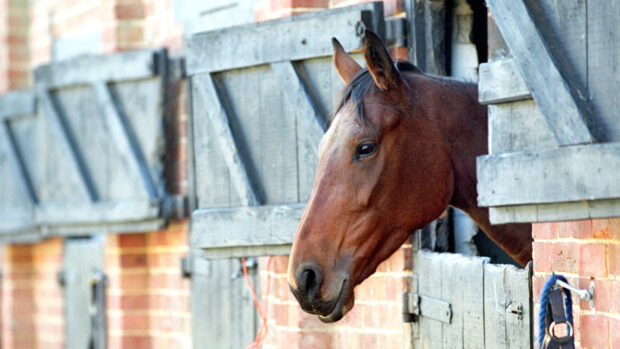Few sport and leisure horses have the luxury of living life as natureintended — instead the needs of their riders result in their confinement to a stable for hours on end, eating cereals rather than grass and enjoying limited exercise.
By allowing your horse to carry out natural behaviour even when confined, however, you can curb stress and boredom levels and reduce the likelihood that he will develop stable vices.
Here are some top tips to keep your horse happy and relaxed from animal welfare charity, The Blue Cross.
Top tips for happyhorses
- Turn out your horse with a companion as often as possible – even an hour a day in a sand school is worthwhile.
- If you have access to a barn or large stable, use it for your horse and his companion to give them a chance to groom and play. Slowly increase the time they are together – 10 minutes is enough to begin with – and then gradually introduce them to smaller spaces.
- If possible, stable your horse next to his friend, or another horse he gets on with, so they can see and touch each other. Even better, lower the internal stable partition or cut a hole in it, enabling both horses to groom each other through the gap. This is an excellent way of reducing stress.
- Provide freedom of movement and choice by creating a pen outside your horse’s stable so that he can choose to be inside or out. You may be surprised at how often he prefers to be outside.
- Invest in some stable toys to alleviate boredom or, with a little imagination, make them yourself: for example carrots, swedes and turnips can be tied from the ceiling with baler twine or horse and pony nuts or strips of carrot can be hidden in the bed.
If your horse or pony has suffered from laminitis or is under veterinary care, you will need to contact your vet before using feed-based toys or anything else that may interfere with veterinary treatment.
- Provide plenty of hay at all times, especially at night, to encourage natural behaviours such as browsing and trickle feeding. Provide hay in a haynet with small holes so it takes your horse longer to eat and gives him a little challenge too.
- Don’t over-rug your horse – allow him to grow his own insulatingcoat. The more rugs you put on, the less he is able to regulate his temperature by himself. Heat can generate quickly, making him hot and sweaty during the night.
- Make sure your horse’s stable is big enough. He should be able to move around easily and lie flat without obstruction.
- Your horse’s stable should also be well ventilated, light and free from dust. Ideally there should be a window at the back to allow air to circulate. Don’t close the top door, as this will only make the stable stuffy and add to any feeling of claustrophobia.
- If your horse exhibits stereotypical behaviour, such as crib biting, don’t prevent it, as it is his way of dealing with a stressful situation. Anti-weave bars and crib collars will only increase his stress levels. Instead, try to identify and eliminate the cause of his anxiety.
Reduce the time spent in the stable to a minimum, then gradually increase the amount of time he is kept in. If this doesn’t work, you may have to search for year-round turnout.
| Click here to subscribe to HORSE magazine, which is packed with horsecare features every month |



